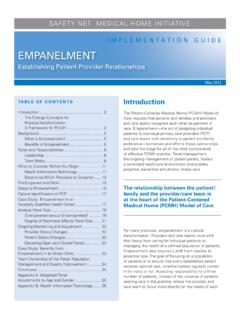Transcription of Common Barriers and Strategies to Support Effective …
1 1 TOOLSORGANIZED, EVIDENCE-BASED CAREC ommon Barriers and Strategies to Support Effective Health care Teams for Integrated Behavioral Health We carefully selected behavioral health providers who were adaptable, flexible who were comfortable being visible and comfortable in approaching providers with offers of assistance. Then when they were invited to see a patient, they would just do it. Janet Rasmussen, Director of Accountable care and Behavioral Health, Clinica Family Health ServicesResearch on high-functioning teams identifies five core principles of Effective teams: shared goals, clear roles, mutual trust, Effective communication, and measurable processes and table below summarizes Common challenges faced in building Effective integrated behavioral health care teams and Strategies for addressing these challenges.
2 Table 1: Common Barriers and Strategies to Support Effective Health care Teams for Integrated Behavioral Health Team Core Principles1 Common BarriersStrategiesShared Goals: The team works together to establish shared goals that are clearly articulated, understood, and supported by all team of appreciation of the core principles of integrated behavioral health pathway Reconsider your vision and vision statement. Make sure there is team buy-in to this vision. At the organizational level, make sure to communicate the clear set of behavioral health goals as well as expectations about how behavioral health will Support your larger PCMH transformation goals.
3 At the patient level, consider starting with a shared problem list with the ultimate goal of one treatment plan that is shared by all team members. Encourage whole team responsibility for quality and outcomes of behavioral health care . Vision is not aligned with resources Consider if vision needs to be adjusted to reflect available resources. Develop leadership buy-in. Identify champion(s) to advocate for resources. Identify and Support resource needs considering both staffing and system requirements. Identify referral resources and partners ( , for social needs). Address funding concerns including anticipated costs for both short-term start-up and long-term sustainability.
4 2 TOOLSORGANIZED, EVIDENCE-BASED CARETeam Core Principles1 Common BarriersStrategiesClear Roles: There are clear expectations for each team member s efforts so that the team effort adds value greater than the sum of its skills in Effective teamwork Identify facilitator/champion to facilitate team building. Consider using a structured process to build the team and develop workflows. Train together with a specific focus on performing in new roles. Plan training and practice-specific collaborative care skills ( , integrated care planning).Individual concerns about scope of practice Clearly define roles through team building within scope of practice for each provider.
5 Seek to understand concerns of providers. Acknowledge strengths of team members and apply those skills to new role(s).Mutual Trust: Team members earn each other s trust, creating greater opportunity for shared time and resources to build team and trust. Schedule adequate time for team building and give the work group a clear timeline. Consider opportunities to foster mutual trust among the care team, especially sharing patient success stories. Create opportunities for team members to get to know each other and interact outside of patient care . Consider a coffee hour or other social activity once a month.
6 Effective Communication:Team communication is a priority and is continuously improved. Clash of cultures Acknowledge that integrating behavioral health into primary care may be challenged by bringing together teams of providers that have often trained in cultures with very different orientations. Focusing on patient goals and linking these to medical and behavioral targets can bridge this culture gap. Lack of orientation Provide orientation to all team members. Promote clear vision of goals for behavioral health integration effort. Lack of skills Practice communication Strategies during a provider meeting (for example, PCP and other medical staff can practice introducing the behavioral health team/provider using a warm handoff role play).
7 Lack of structure Develop workflow with special attention to method and timing of team member communication. Use HIT for simple communication: some team training around using messaging Strategies within EHRs. Plan for nuanced conversations to be handled in person, over the telephone or at a team huddle/case conference. Hold case conferences for all members of a team to meet and discuss challenging patients. 3 TOOLSORGANIZED, EVIDENCE-BASED CARETeam Core Principles1 Common BarriersStrategiesMeasurable Processes and Outcomes: The team agrees to continuously monitor and adjust functioning of the team and achievement of team feedback on team functioning and team goals.
8 Consider sharing data regularly at provider meetings and engage your whole organization in quality improvement activities to foster your high-functioning team. Review behavioral health integration effort effectiveness in regularly scheduled QI meetings after effort launch and identify needs for additional training and resources. Reflect on team functioning as part of staff meetings. References1 Mitchell P, Wynia M, Golden R, et al. Core principles & values of Effective team-based health care . Institute of Medicine of the National Academies. October 2012. Available here.
9 Accessed July Net Medical Home Initiative The Organized, Evidence-Based care Supplement: Behavioral Health Integration is a component of the Safety Net Medical Home Initiative Implementation Guide Series. The goal of the Safety Net Medical Home Initiative (2008-2013) was to develop and demonstrate a replicable and sustainable implementation model to transform primary care safety net practices into patient-centered medical homes with benchmark performance in quality, efficiency, and patient experience. The Initiative was administered by Qualis Health and conducted in partnership with the MacColl Center for Health care Innovation at the Group Health Research Institute.
10 Five regions were selected for participation (Colorado, Idaho, Massachusetts, Oregon, and Pittsburgh), representing 65 safety net practices across the The partner sites and Regional Coordinating Centers that participated in the SNMHI were members of a learning community working toward the shared goal of PCMH transformation. The SNMHI Implementation Guide Series was informed by their work and knowledge, and that of many organizations that partnered to Support their efforts. The SNMHI was supported by The Commonwealth Fund, a national, private foundation based in New York City that supports independent research on health care issues and makes grants to improve health care practice and policy.










